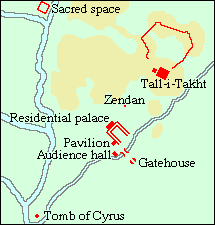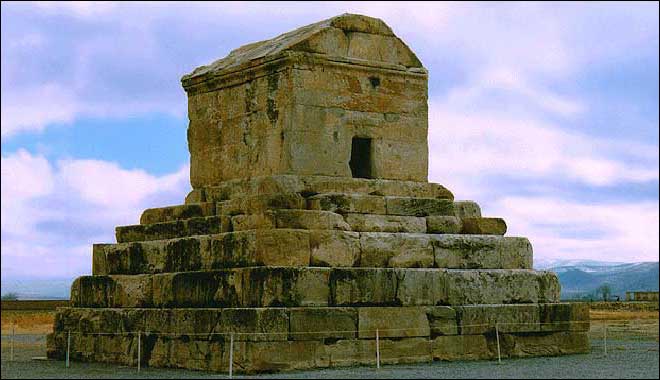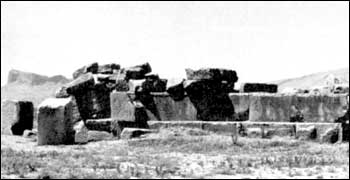History of Iran: Pasargadae (original) (raw)
Pasargadae
In old Persian Pâthragâda: oldest of the capitals of the ancient Achaemenid empire, built by the founder of this empire, king Cyrus the Great (559-330 BCE). It resembled a park of 2x3 km in which several monumental buildings were to be seen.
 |
|---|
| Map of Pasargadae |
According to the Roman geographer Strabo of Amasia, Pasargadae was built on the site where king Cyrus defeated the leader of the Medes, Astyages, in 550 BCE (Strabo, Geography 15.3.8). That Cyrus was indeed the builder of this town, can be corroborated from the building inscriptions in the palace, which state Cyrus the Great King, an Achaemenian.
The heart of Pasargadae is the citadel, which is known as Tall-i-Takht or 'throne hill'. It overlooks a garden ('paradise') in the south, and the palace complex itself. This consists of two smaller units: the residential palace and the many columned audience hall. The audience hall or Apadana can be approached from the south-east; the visitor first has to pass a gate and then has to cross a bridge over the river Pulvâr.
Stylistically, the Apadana belongs to the architectural tradition of the Iranian nomads, who lived in large tents. However, Cyrus used elements from other cultures as well: sculptures from the Assyrian palaces were used as models, work was done by stonemasons from Greek Ionia, and a Phoenician demon guarded the palace. Probably, the population of the city had a similar, mixed character.
The small tomb of king Cyrus -stylistically based on a model from western Turkey- is situated a little to the southwest. It was venerated by later rulers, a.o. the Macedonian king Alexander the Great, who ordered restorations in January 324 BCE. The tomb of Cyrus' successor
Cambyses was never finished.
 |
|---|
| The tomb of Cyrus |
King Darius I the Great (522-486 BCE) built a new capital, Persepolis, forty-three kilometers downstream along the river Pulvar. However, Pasargadae remained an important place, probably as the religious capital of the Achaemenid empire where the inauguration of the kings took place.

 |
|---|
| Unfinished tomb of Cambyses, Pasargadae |
Literature
- E. Badian, 'Alexander the Great between two thrones and Heaven: variations on an old theme' in: Alastair Small (ed.), Subject and Ruler: the Cult of the Ruling Power in Classical Antiquity (1996 Ann Arbor)
- D. Stronach, Pasargadae 1978. This book is summarized and updated by the author as 'Pasargadae' in Ilya Gershevitch (ed.): The Cambridge History of Iran, vol. II: The Median and Achaemenian Periods, 1985 Cambridge, pages 838-855.